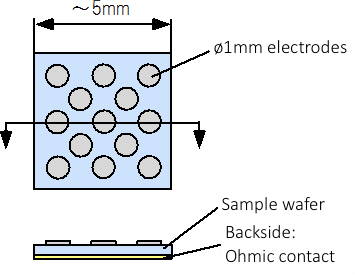Detailed explanation of DLTS method
Here, we explain the basic principles of so-called transient spectroscopy, such as DLTS method and ICTS method.
DLTS / ICTS methods are essentially based on the same measurement principle in that they monitor the carrier emission process from the deep level through transient changes in the junction capacitance of the sample.
Therefore, when not particularly comparing and contrasting these two methods, they are simply described as DLTS as in the following.
Since DLTS method was devised by Lang 1) in 1974, various improvements have been added. First of all, we will describe Lang's method as a "conventional method or traditional DLTS method" and then briefly touch on the current technology trends (or advancements).
Measurement sample
In the DLTS method, according to its measurement principle, a sample having a so-called semiconductor junction (Schottky, pn or MIS structure) is required.
Therefore, for example, when evaluating deep level in bulk semiconductor material, a sample with a so-called Schottky diode structure needs to be created by forming a Schottky junction by depositing a metal electrode on the surface and an ohmic electrode on the back side.
If a measurement sample is a device with original diode structure, it can be used for measurement as is.

Measurement principle
In this section, we will explain the measurement principle with an n-type Schottky junction sample, however, there is no change in the basic principle even in the case of pn junction and MIS structure.
●Bibliography
1) D. V. Lang, J. Appl. Phys. 45, 3023 (1974).
